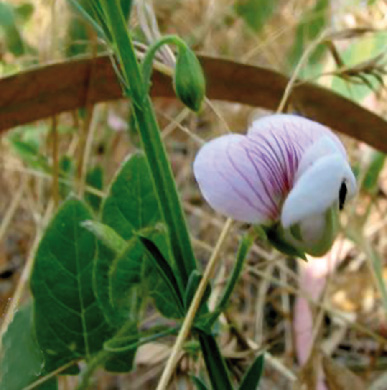Lathyrus cassius: Red Data Book of Armenia

EN B 1 ab(i,ii,iii,iv) + 2 ab(i,ii,iii)
Category. Endangered species. The extent of occurrence and the area of occupancy are less than 500 km2. It was not included in the first edition of the Red Data Book of Armenia. It is not included in the Annexes of CITES and that of the Bern Convention.
Description. Annual plants. Stems narrowly winged, branched, 30–90 cm. Leaflets 1–paired, linear, 30–70 x 2–5(8) mm; leaf rachis ending in branched tendril. Peduncles 1(2)–flowered, glandulose. Calyx glandulose; teeth widely triangular–ovate. Corolla yellow at the beginning of flowering, later flag becomes pinkish–violet with dark veins, 11–13 mm long. Legumes, especially immature ones, covered with gold–shining sessile glands, 30–40 x 5–6 mm. Seeds torulose.
Distribution. In Armenia it grows only in Zangezur (surroundings of Goris town, "Shikahogh" State Resereve, surroundings of Agarak and Yehgvard villages) floristic region. EOO is 380 km2, AOO is 24 km2, the number of locations is 3. Besides Armenia the species grows in Anatolia, Lebanon, Cyprus, Syria, Palestine, Iraq, Iran.
Ecological, biological and phytocoenological peculiarities. Grows in lower and middle mountain belts, at the altitude of 750–1400 meters above sea level, in oak–hornbeam forests, in the shibliak. Flowering from June to July, fruiting from July to August.
Limiting factors. Restricted extent of occurrence and area of occupancy, small density of the population, loss/degradation of habitats caused by land development.
Conservation actions. Part of the population grows in "Shikahogh" State Reserve. Necessary: monitoring of the population state.
Suggestions
 The Ministry of Environment sent a letter international partners to draw their attention to the real danger of environmental disasters as a result of Azerbaijan's large-scale aggression towards the territory of Armenia
The Ministry of Environment sent a letter international partners to draw their attention to the real danger of environmental disasters as a result of Azerbaijan's large-scale aggression towards the territory of Armenia
 Vicia pisiformis: Red Data Book of Armenia
Vicia pisiformis: Red Data Book of Armenia
 Vavilovia formosa: Red Data Book of Armenia
Vavilovia formosa: Red Data Book of Armenia
 Trigonella capitata: Red Data Book of Armenia
Trigonella capitata: Red Data Book of Armenia
 Trigonella astroides: Red Data Book of Armenia
Trigonella astroides: Red Data Book of Armenia












